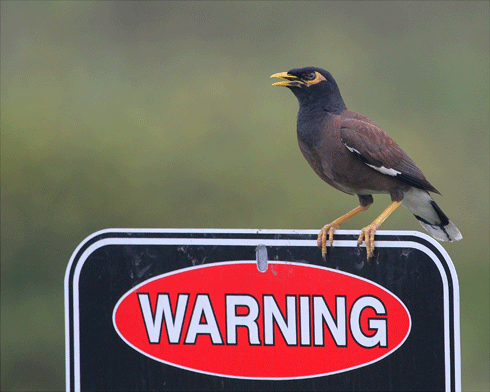
|
Published: 20 August 2012
It’s official: Indian mynas harm native bird populations
New research confirms that the Indian or common myna has an adverse effect on native and other bird species by competing with them for food, nesting sites and territories.
The research – by the Invasive Animals Cooperative Research Centre and the Australian National University, using Canberra as a case study – shows Indian mynas have an adverse impact on populations of sulphur-crested cockatoo, crimson rosella, laughing kookaburra, superb fairy-wren, striated pardalote, willie wagtail, grey fantail, magpie-lark, silvereye and common blackbird.
The survey results show the abundance of sulphur-crested cockatoo in Canberra prior to establishment of Indian mynas increased each year. However, after Indian mynas established a population in the city, the growth in sulphur-crested cockatoo abundance decreased.
Similarly, crimson rosella abundance increased throughout the survey period but declined after Indian mynas established a foothold in Canberra; kookaburra populations also suffered.
‘Indian mynas affect native and other birds in three ways,’ explained project researcher Kate Grarock. ‘They compete for food. They compete for cavity-nesting sites, so reducing the breeding success of other species. They compete for territories.’
The Indian myna has been shown to actively defend up to three hectares, feed within an area of up to two kilometres from a communal roost, and build and defend multiple nests as a deterrent to other cavity-nesting species.
Previous attempts to investigate the impact of Indian mynas have relied on short-term data (from one to three years) with limited success. The Canberra study used long-term data gathered over 29 years by the Canberra Ornithologists Group.
Ms Grarock’s analysis of the data began in 2007, following consultation between the Canberra Indian Myna Action Group (CIMAG), the Invasive Animals CRC and the ANU’s Fenner School of Environment and Society.
The Indian Myna was first brought to Australia in 1862 to control insects in market gardens in the city of Melbourne. The species quickly established in Melbourne and that population became a source population for other introductions in eastern Australia.
The species was deliberately introduced to Canberra between 1968 and 1971, when 110 birds from Sydney were released in the suburb of Forrest.
By 2006, a mid-range estimate of the population in the ACT was 93,000. Humane trapping programs have since removed more than 42,000 Indian mynas.
CIMAG also supports MynaScan, a citizen science initiative allowing members of the community to map myna sightings, and damage and control activities associated with mynas in their area.
The International Union for the Conservation of Nature has ranked the Indian myna among the world’s top 100 most invasive plants and animals. They thrive in and around human-modified environments, reaching high densities of more than 200 birds per square kilometre in towns.
Source: Invasive Animals CRC




